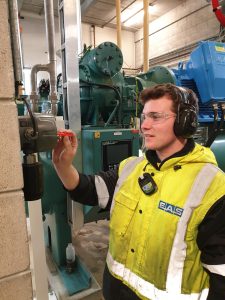Halloween Riddles
Q: How do you fix a broken Jack-o-lantern?
A: With a pumpkin patch
Q: Why didn’t have the mummy have any friends?
A: He was too wrapped up in himself.
Q: What do you get if you cross a snowman with a witch?
A: A cold spell.
Q: How do you fix a broken Jack-o-lantern?
A: With a pumpkin patch
Q: Why didn’t have the mummy have any friends?
A: He was too wrapped up in himself.
Q: What do you get if you cross a snowman with a witch?
A: A cold spell.
Circuit breakers are automatically operated electrical switches designed to protect an electrical circuit from damage caused by excess current from an overload or short circuit.
The basic function of a circuit breaker is to interrupt the current flow when a fault is detected. Unlike a fuse, which operates once and then must be replaced, a circuit breaker can be reset (either manually or automatically) to resume normal operation.
Circuit Breakers play a critical role in protecting expensive equipment in your plant. However, they can go long periods without activation, so it is essential that they are regularly maintained and tested. If they fail to activate when needed it could have catastrophic consequences for your staff and plant if an arc flash were to occur and would result in extensive damage to your plant’s electrical systems.
Primary & Secondary injection testing of your circuit breakers should be included as part of your Preventative Maintenance plan to ensure their reliability and safety.
Primary Injection Testing vs Secondary Injection Testing
Primary Injection Testing injects a multiple of the fault rated current of the breaker through the breaker to measure the trip time.
Secondary Injection Testing injects a ratio of the fault rated current directly into the trip unit and measures how long the breaker takes to trip.
The primary tests of the breaker are closer to a real-world scenario while secondary tests the timing and functioning of the trip unit.
Primary injection testing is usually the preferred test method as it tests the entire circuit including the current sensors, wiring and the current conduction path in the circuit breaker as part of the test. However, it is also more expensive, so is generally conducted at commissioning and on circuit breakers that are part of a critical process or engineered safety system. Other than trip testing other tests that can be conducted as part of your primary injection testing include:
– Power Transformers (Through Faults)
– Relay Testing
– Bus-work, Switchgear and HV Breakers
– Low voltage breakers
– Switchgear Testing
– Heat runs
– Stability tests
– Loose Connections
– Core Identification
If you need help incorporating primary and secondary injection testing as part of your preventative maintenance programme get in touch with the EAS team today on 07 834 0505 or [email protected].


Answer: Trouble

Answer: A hole
Programmable Logic Controllers (PLCs) are used by businesses around the world to automate their manufacturing processes to ensure accuracy, consistency and improved efficiency and safety.
PLCs were originally developed in the late 1960s by the US automotive industry to replace relay logic systems. These systems were difficult to update or alter the automation process due to being hard-wired. Any changes to the automation process, using relay logic, meant rewiring and updating documentation. Even a single misplaced wire or failed relay could render the the whole system faulty, making troubleshooting a time-consuming process.
In comparison, PLCs use a tiny computer that takes inputs from data capture points and human input points such as switches and buttons. Based on its programming, the PLC then decides whether or not to change the output. PLC outputs can control a wide range of equipment including motors, solenoid valves, lights, switchgear, safety shut offs and many more.

Advantages of PLCs
The EAS team have extensive experience working on projects utilising PLCs. If you’re looking for assistance with installing or upgrading your processes with PLCs, get in touch with the EAS team today on 07 834 0505.
A puzzle piece
In the event of a power outage, a generator is essential to keeping your your facility running. However, to ensure you have a truly reliable backup power system your generator must be regularly maintained so it is ready to operate when you need it.
By implementing an electrical preventative maintenance plan for your generator, you ensure:
Electrical Preventative Maintenance Checks for your generator:
Your generator electrical preventative maintenance plan should include:
By prioritising electrical preventative maintenance for your generators, you can minimise the risk of unexpected failures, ensuring the safety of your team and equipment and achieve long-term cost savings with optimised performance.
If you would like to get an electrical preventative maintenance plan in place for your generator to give you peace of mind that you’ll have power when you need it; get in touch with the EAS team today on 07 834 0505.

Ammonia is widely utilised in industrial processes and refrigeration systems due to its cost-effectiveness and energy efficiency. It also boasts an environmentally friendly profile with an Ozone Depletion Potential (ODP) of 0 and a Global Warming Potential (GWP) of 0, making it a popular choice for industrial refrigeration.
While there are significant benefits to using ammonia, we must still remember it is a toxic gas capable of causing harm to both human health and the environment. In the event of a leak whether due to equipment malfunction, human error, or system failure; ammonia has the potential to cause serious health issues for your team including respiratory problems, eye irritation, skin burns, and in severe cases, even death. Additionally, ammonia concentrations between 16-25% can also pose an explosion risk.
due to equipment malfunction, human error, or system failure; ammonia has the potential to cause serious health issues for your team including respiratory problems, eye irritation, skin burns, and in severe cases, even death. Additionally, ammonia concentrations between 16-25% can also pose an explosion risk.
Fortunately, the risks associated with ammonia usage can be mitigated with the use of ammonia gas detectors. These detectors serve as an early warning system, alerting operators to the presence of ammonia gas before it reaches hazardous levels. This allows swift action to be taken, including isolating the source, activating ventilation systems, and implementing safety protocols to protect workers and prevent the situation from worsening.
Gas detectors can either be fixed or portable.
Fixed detectors are permanently installed onsite. They continuously monitor an area around the detector, typically a 5m radius. Fixed detectors work in a similar manner to fire and smoke alarms, where if gas levels reach a certain level, audio and visual alarms are triggered. More advanced installations may also be able to alert other monitoring systems or activate the shutdown of systems.
Portable gas detectors are designed to be carried or worn clipped to an item of clothing. They form part of a person’s PPE. They are designed to provide alarms to the wearer when target gas levels exceed safety limits.
Whichever form of gas detector you use, it is essential that they are regularly maintained and calibrated. The EAS team recommends six monthly calibrations of your ammonia sensors to ensure they maintain optimal functionality and reliable measurements.
If you’d like to find out more about gas detectors or set up a regular calibration plan, get in touch today on 07 834 0505.
I can be written,
I can be spoken,
I can be exposed,
I can be broken.
What am I?
The news